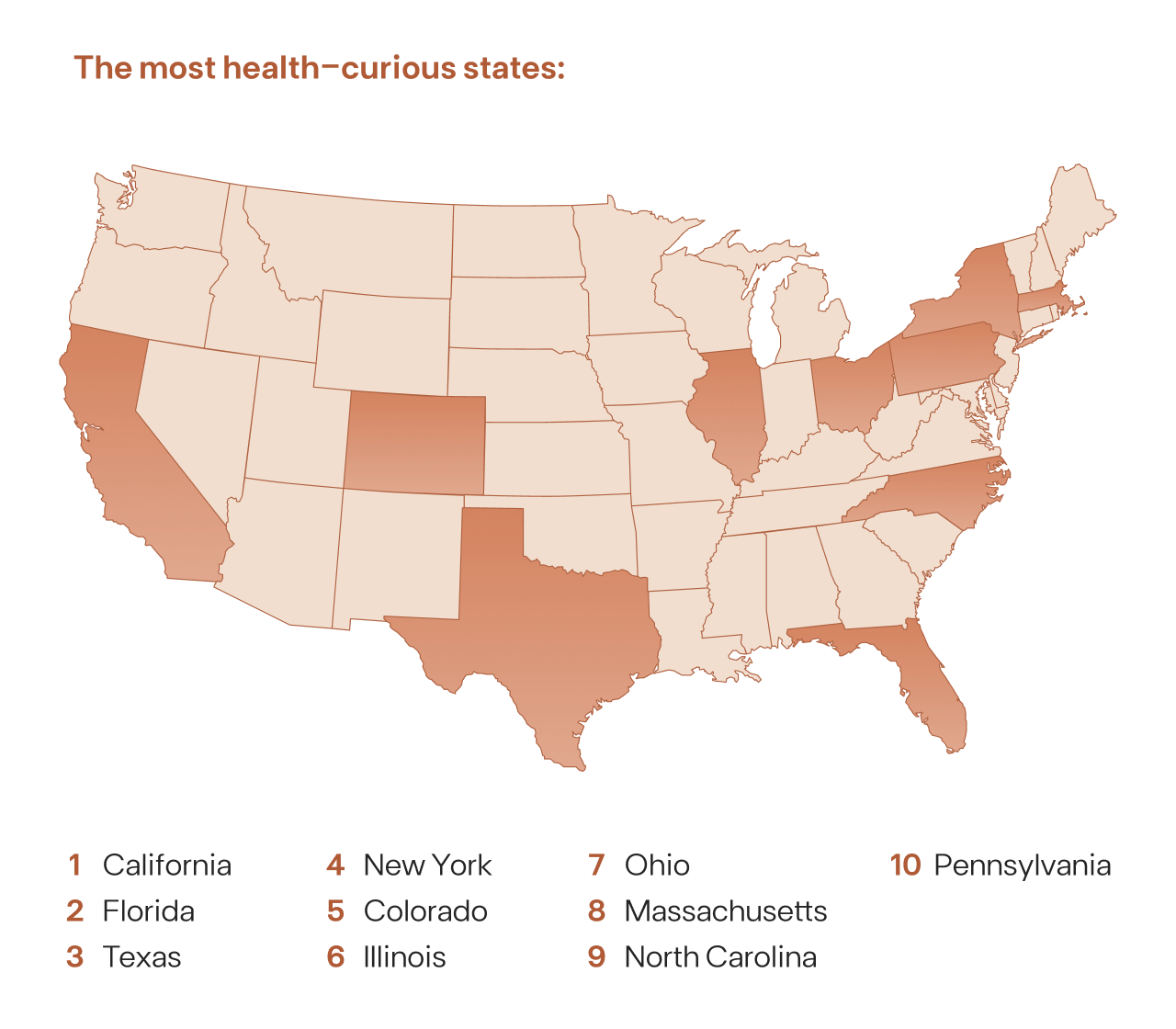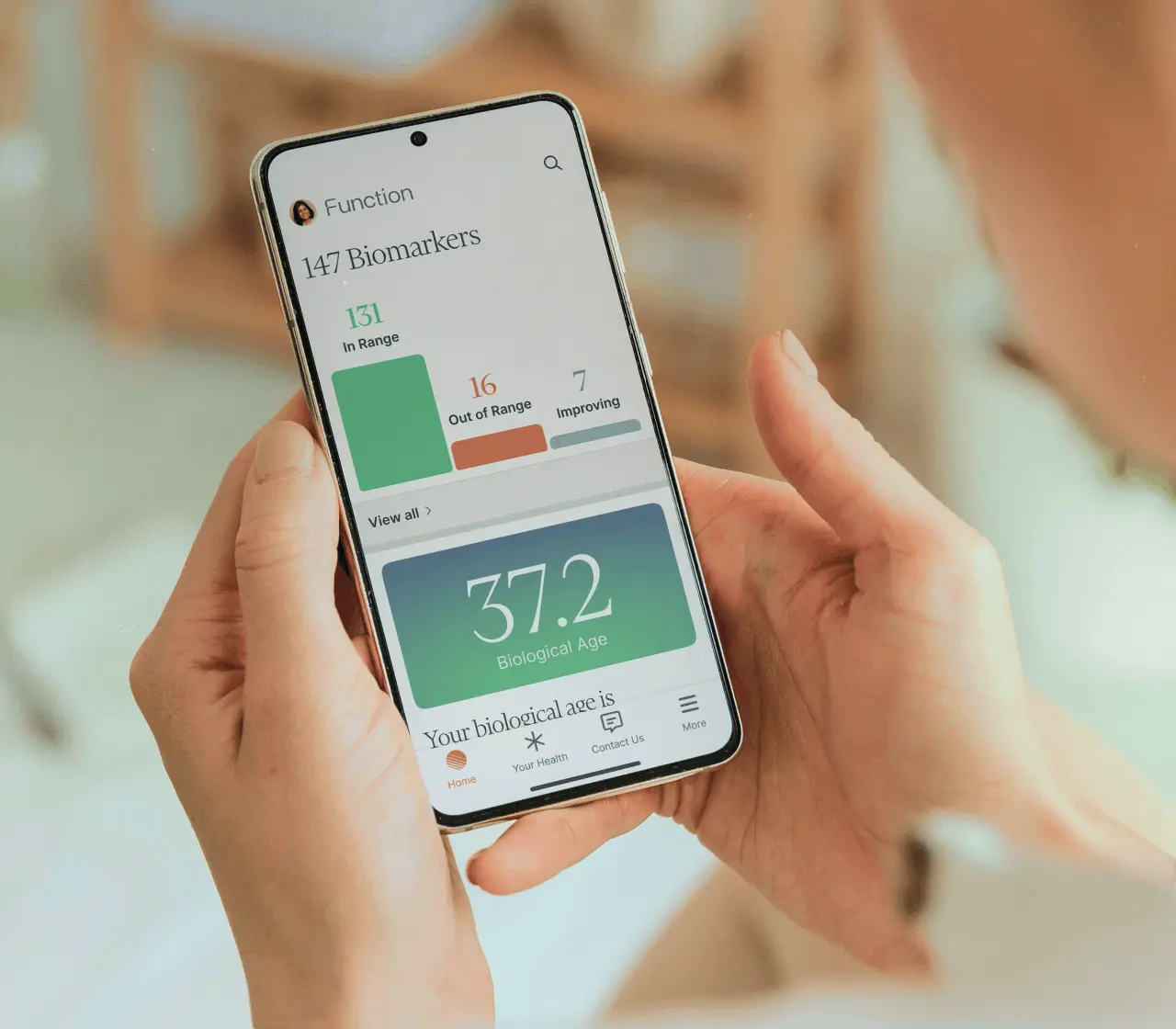The Function Index
The Function Index
Function members have tested 50 million biomarkers
Function members have tested 50 million biomarkers
wanted to take control over their health
wanted access to whole-body testing
were not happy with their primary care provider
were managing a chronic condition
State of health
Function members come from every part of the country—but some states showed a stronger interest in testing than others. California, Florida, and Texas lead in total members, as expected from population size. But states like Colorado and Massachusetts stand out for outsized membership compared to their population size.

Don’t panic: A lot of your results were normal. And we love to see it
Because health isn’t always about extremes or change. Sometimes it’s about staying in the normal range, year after year.
Over 97% of members had uric acid levels within range, supporting healthy kidney function and lowering the risk of metabolic disorders.
Over 97% of members had uric acid levels within range, supporting healthy kidney function and lowering the risk of metabolic disorders.
Over 99% had low levels of lead, reflecting minimal environmental exposure and effective elimination
Over 99% had low levels of lead, reflecting minimal environmental exposure and effective elimination
Over 80% had in-range liver and kidney results
Over 80% had in-range liver and kidney results
Over 90% had in-range pancreas results
Over 90% had in-range pancreas results

Advanced lab testing catches what routine checkups and annual screenings can miss
Advanced lab testing catches what routine checkups and annual screenings can miss
Function membership includes 160+ lab tests annually across every major organ system, selected by the world’s top doctors based on the latest science around disease detection and long-term health impact.
Here’s what came up most often for Function members.
Here’s the nitty-gritty
Here’s the nitty-gritty
Function members can uncover risks that standard cholesterol testing alone may miss. Here’s what thousands of Apolipoprotein B (ApoB), Lipoprotein(a) [Lp(a)], high-sensitivity C-reactive protein (hs-CRP), and Omega-3s lab tests revealed.
54% had elevated ApoB, which is not typically tested unless by a cardiologist.
High levels of ApoB is a powerful indicator of increased cardiovascular risk.
23% had elevated Lp(a), which can reveal an inherited risk for heart disease.
High Lp(a) increases the risk of heart problems even when other cholesterol numbers look normal. It’s not usually measured in standard cholesterol tests.
40% of members had hs-CRP levels above optimal levels, whereas 14% had hs-CRP levels that significantly elevates risk of cardiovascular disease.
A high level of hs-CRP is associated with inflammation and increased risk of cardiovascular disease.
10% showed elevations in both hs-CRP and Lp(a).
The combination of systemic inflammation and increased genetic risk is associated with worse cardiovascular disease outcomes like heart attack and stroke.
7% showed elevated hs-CRP, Lp(a), and LDL Cholesterol.
This reflects a combination of inflammation, genetic risk, and high circulating LDL cholesterol—factors that together greatly heighten the risk of cardiovascular disease, especially in women
Almost 25% were in the lower quartile for Omega-3 fatty acids.
Lower Omega-3s values are associated with a higher risk for cardiovascular disease.
FYI:
- ApoB results provide a direct count of plaque-forming cholesterol particles in the blood.
- Lp(a) is a cholesterol-related particle mostly determined by genetics.
- hs-CRP is produced in the liver and released into the blood in response to various inflammatory triggers, ranging from infection to chronic stress.
- Omega-3s test measures the percentage of total omega-3 fatty acids (EPA+DPA+DHA).
Thyroid-Stimulating Hormone (TSH) is often the only thyroid metric tested by doctors. Function looked deeper—and uncovered signs of autoimmune thyroid disease.
About 15% of women tested had elevated thyroid antibodies (TgAb or TPO) despite having normal TSH levels.
Thyroglobulin Antibodies (TgAb) and Thyroid Peroxidase (TPO) antibodies are important markers for autoimmune thyroid conditions like Hashimoto’s thyroiditis.
Even when thyroid hormone levels appear normal, the presence of TgAb or TPO can indicate a higher risk of future thyroid problems.
About 23% of our members showed increased levels of autoimmune antibodies.
This could suggest a growing trend toward immune dysregulation and early autoimmune activity.
FYI:
- TPO are antibodies produced by the immune system that mistakenly target and attack the TPO enzyme, essential for the production of thyroid hormones.
- TgAb are antibodies that target thyroglobulin, a key precursor for thyroid hormone production.
In women tested, Follicle-Stimulating Hormone (FSH) levels doubled between their 20s and 30s, suggesting that hormonal changes linked to perimenopause may begin earlier than many expect.
FYI:
- Measuring FSH can provide insight into fertility, ovarian health, perimenopause, menopause, polycystic ovary syndrome (PCOS), and causes of irregular periods.
Elevated fasting insulin can be present for years before signs of prediabetes or type 2 diabetes show up in standard tests, which often only test for glucose.
More than 65% were outside the optimal range for fasting insulin.
Over 50% had high fasting insulin but normal glucose.
Over 50% also had high fasting insulin but normal HbA1c.
FYI:
- Elevated fasting insulin may be an early sign of insulin resistance and related metabolic disorders such as type 2 diabetes.
- Insulin isn’t routinely tested in standard checkups, but measuring it can sometimes help detect signs of diabetes risk earlier.
- Hemoglobin A1c (HbA1c) measures average blood sugar over 2-3 months.
Only 14% of cancers are found through routine screenings
Only 14% of cancers are found through routine screenings
Cancer detection
Function offers members access to the GRAIL Cancer Test*, which looks for cancer signals across 50+ types of cancer before they become symptomatic.
Among female members with a breast cancer signal detected, 14% were under 40, below the recommended age to start screening.**
Among members with a lung cancer signal detected, 44% were under 50, below the recommended age to start screening current smokers or those with a history of smoking.**
Among members with a colorectal cancer signal detected, 6% were under 45, below the recommended age to start screening.**

Scans
In May 2025, Function acquired Ezra to give Function members access to affordable MRI and CT scans.*
Why scans? Because they can see more—often before symptoms appear.
Almost 5% of Ezra members have had a highly suspicious finding for cancer.
MRI scans: These safe, fast, and powerful scans screen for hundreds of conditions and potential cancers in up to 13 organs.
Low-dose CT scans: Heart & lung CT scans can help detect signs of lung cancer, pulmonary nodules, emphysema, and more.
CAC scores: Following a CT scan, advanced AI analysis provides a coronary artery calcium (CAC) score to help evaluate the risk of heart disease.

Big on the internet
Our social media feeds are filled with health hacks, half-truths, and self-diagnoses. It’s easy to latch onto these when we’re in search of clarity—but health is personal.
That’s where biomarker testing comes in.
Biomarkers—biological markers—are the objective, measurable indicators that can reveal what’s actually going on in your body. Testing them offers something your algorithm can’t: context grounded in your biology and evidence-based medicine.

The biomarkers behind the buzz
The biomarkers behind the buzz
There’s more to male hormones than just testosterone. Look at the bigger picture (and your specific test results).
In our members, testosterone levels declined with increasing age—as expected—but there’s more to the story.
14% of men tested, including roughly 17% between the ages of 20-29, had elevated Estradiol (E2) levels, which is linked to metabolic dysfunction, inflammation, and an increased risk of cardiovascular disease.
Higher E2 relative to testosterone has also been associated with obesity, insulin resistance, atherosclerosis, and erectile dysfunction, suggesting that maintaining a healthy hormone ratio is necessary for long-term metabolic and vascular health.
Follicle-Stimulating Hormone (FSH) and Luteinizing Hormone (LH)—hormones that regulate reproductive health and testicular function—were found to rise significantly in men under 40. FSH levels of tested members doubled, and LH levels tripled between the 20s and 40s age ranges.
This early increase may be linked to chronic health issues like diabetes or to lifestyle factors such as heavy alcohol use and chronic stress, which can contribute to lower testosterone levels and related symptoms.
Cases are rising in people in their 20s, 30s, and 40s—possibly driven by sedentary lifestyles, alcohol misuse, high body fat %, and diets packed with processed foods. Yet screening isn’t officially recommended until age 45.**
Among Function members with a colorectal cancer signal detected by the GRAIL Cancer Test,* 6% were under 45.
The good news? With early detection, the survival rate is 91%.
*Available for an additional cost.
**According to USPSTF screening recommendations.
Promises of sharper focus, better memory, and endless hacks to “reset your dopamine” are everywhere online—and Americans are spending billions a year on brain-health boosters, often with only modest or inconsistent results.
But understanding your measurable brain health biomarkers can provide a clearer picture of better brain health.
Nearly 38% of our members were found to be deficient in key nutrients like vitamin B12, omega-3 fatty acids, vitamin D, and magnesium.
These nutrients have a direct impact on brain health, affecting memory, focus, mood, and, especially, important to prevent neurodegenerative diseases like Alzheimer’s.
14% of members were identified with elevated levels of phosphorylated tau217 (p-tau217), a strong prognostic marker for Alzheimer's disease.
Elevated p-tau217 is a direct indicator of neurodegenerative changes in the brain, aiding in early detection and providing an opportunity to address modifiable risk factors such as diet, physical activity, smoking, and mental and social engagement to support brain health.
